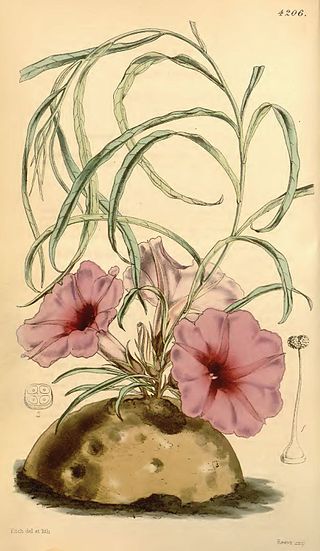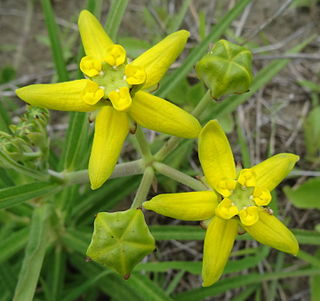Spondianthus is a genus of plant, in the family Phyllanthaceae and is the only genus comprised in the tribe Spondiantheae. It was first described as a genus in 1905. The genus contains only one recognized species, Spondianthus preussii, widespread across much of tropical Africa from Liberia to Mozambique.
- Spondianthus preussii subsp. glaber(Engl.) J.Léonard & Nkounkou – from Nigeria to Tanzania south to Angola; also Guinea, Ivory Coast
- Spondianthus preussii subsp. preussii – from Liberia to Zaire
Mildbraedia is a plant genus of the family Euphorbiaceae first described as a genus in 1909. The entire genus is native to Africa.
- Mildbraedia carpinifolia – Kenya, Tanzania, Mozambique
- Mildbraedia klaineana – Republic of the Congo, Democratic Republic of the Congo, Cabinda, Gabon
- Mildbraedia paniculata – Democratic Republic of the Congo, Gabon, Ghana, Ivory Coast, Liberia

Ferdinand Albin Pax was a German botanist specializing in spermatophytes. A collaborator of Adolf Engler, he wrote several monographs and described several species of plants and animals from Silesia and the Carpathians. He was a professor at Wrocław University from 1893. His son Ferdinand Albert Pax (1885–1964) was a noted zoologist.
Cuphocarpus is an obsolete genus of flowering plants in the family Araliaceae. Mabberley (2008) treated it as a synonym of Polyscias, but other authors still recognized it at that time. In 2010, in a phylogenetic analysis of DNA sequences, it was shown that Cuphocarpus was biphyletic and embedded in the large genus Polyscias. In an accompanying paper, Polyscias was divided into 11 subgenera, with seven species left incertae sedis.

Ursinia is a genus of African plants in the chamomile tribe within the daisy family. The genus is named in honor of German scholar Johannes Heinrich Ursinus 1608–1667.
Lifago is a genus of flowering plants in the tribe Inuleae within the family Asteraceae.

Ipomoea simplex is a central and eastern Southern African grassland species of Convolvulaceae or Sweet Potato family, notable for its large tuber or root, often eaten raw by Xhosa and Sotho herd boys. Carl Peter Thunberg first described this species in the Prodromus Plantarum Capensium of 1794. 'Ipomoea' = 'worm-like', in reference to the twining habit of the genus.

Reinhold Conrad Muschler aka Reno Muschler, was a German botanist, explorer and writer, who worked on the taxonomy of North African flora. He travelled extensively with Ernest Friedrich Gilg (1867–1933) and carried out a revision of the flora of Patagonia. His parents were both well-known singers at the Court Opera in Berlin.

Ursinia anthemoides or solar fire is an annual, herbaceous flowering plant of the genus Ursinia, native to the Cape Provinces of South Africa. It has yellow or orange daisy-like inflorescences. Fruits have both pappus and hairs, making the seeds easily dispersed by wind.
Ernst Georg Pritzel was a German botanist.
Woodia is a genus in the family Apocynaceae first described as a genus in 1894. It is native to southern Africa
- Woodia mucronataN.E.Br.
- Woodia singularisN.E. Br.
- Woodia verruculosaSchltr.

Stigmatorhynchus is a genus of plants in the Apocynaceae, first described as a genus in 1913. It is native to Africa.
- Stigmatorhynchus hereroensisSchltr. - Damaraland region of Namibia
- Stigmatorhynchus steleostigma(K. Schum.) Schltr. - Somalia
- Stigmatorhynchus umbelliferus(K. Schum.) Schltr. - Tanzania

Stenostelma is a genus of plants in the family Apocynaceae, first described as a genus in 1894. It is native to southern Africa, ranging from Mozambique, Zambia, and Namibia to South Africa.

Stathmostelma is a genus of plants in the family Apocynaceae, first described as a genus in 1893. It is native to Africa.

Patosia is a monotypic genus of flowering plants in the family Juncaceae. It was described as a genus in 1890.
Pentarhopalopilia is a genus of plants in the family Opiliaceae described as a genus in 1987.
Maschalocephalus is a genus of plants in the family Rapateaceae first described in 1900.
Tridesmostemon is a genus of the plant family Sapotaceae described as a genus in 1905.
Charadrophila is a genus of flowering plants in the family Stilbaceae described as a genus in 1899. There is only one known species, Charadrophila capensis, native to the Cape Province region of South Africa.

Sesamum marlothii is a species of flowering plant in the same genus as sesame. It is native to western South Africa. It was originally described as similar to S. schinzianum but differing in various ways, including having the lower leaves with three parts, shorter stalks of the flowers and fruit, capsules half the size, and somewhat larger seeds.














